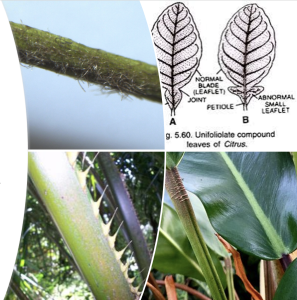46 More Leaf Features
Wait – there are more leaf features!
So far we have talked about features that are fairly easy to see on the plant.
However sometimes we need to take a much closer look to recognise some plants. This may mean using a hand lens or microscope.
Consider the following additional features when identifying plants:
- Petioles
- Glands
- Stipules
- Hairs and scales
- Sap
Petiole
“The little foot” or “stem” of the leaf.
Features that can help identify a plant include petiole length, shape, swollen, ridged, colour, hairy, or with sap.
Petioles come in many shapes, sizes, colours and textures- which help differentiate the plants form each other.
Not all leaves have petioles.
If a leaf doesn’t have a petiole it will be considered sessile.
Most Liliopsida plants will have a sheathed petiole.
Have a look at all the leaves in the class and see what you notice about the petiole.
Glands
Glands are pits, pores and swollen areas on leaves that are often too small to see with unaided eyes.
Depending on the species they can be found on the:
Petiole and margin glands can be very important to help identify Acacia species (wattles). Run your finger tip along the edge of the leaf and petiole – take a closer look if you feel a bump!
Stipules
Small leaf-like growths found near the base of the petiole or on the branch near the petiole. Often stipules protect floral or vegetative buds.
See the image of stipules on a common Northern Australian tree, Nauclea orientalis ( you may know it as Leichardt tree or Leichardt pine.)
Hairs and scales
Sometimes leaves and stems feel very smooth. Sometimes they feel rough, velvety or hairy and this is a sign they have hairs or scales on their surface. Hairs are very narrow (finer than human hair) and scales are wider.
Note the three hair types on the left and two scale types on the right hand side showing the width difference:
 Source: New South Wales Flora Online accessed 3/2/15 at http://plantnet.rbgsyd.nsw.gov.au/cgi-bin/NSWfl.pl?page=nswfl&glossary=yes&term=hair&ill=Fig.+15+
Source: New South Wales Flora Online accessed 3/2/15 at http://plantnet.rbgsyd.nsw.gov.au/cgi-bin/NSWfl.pl?page=nswfl&glossary=yes&term=hair&ill=Fig.+15+
You will need to use a hand lens or microscope to see them clearly. Bend a leaf or twig or wrap it around a finger to make it easier. If you find anything take a closer look – are the hairs simple, like human hair, or branching or connected to glands?
